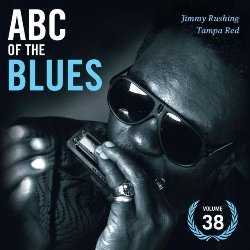ABC of the Blues CD38 (2010)
ABC of the Blues CD38 (2010)

CD 38 – Jimmy Rushing & Tampa Red 38-01 Jimmy Rushing – Good Morning Blues 38-02 Jimmy Rushing – See See Rider 38-03 Jimmy Rushing – Take Me Back, Baby play 38-04 Jimmy Rushing – Sent for You Yesterday 38-05 Jimmy Rushing – Roll’em Pete 38-06 Jimmy Rushing – My Friend Mr. Blues 38-07 Jimmy Rushing – Every Day 38-08 Jimmy Rushing – Sometimes I Think I Do 38-09 Jimmy Rushing – Take Me with You, Baby 38-10 Jimmy Rushing – Evenin’ 38-11 Tampa Red – You Missed a Good Man 38-12 Tampa Red – She Want to Sell My Monkey 38-13 Tampa Red – She’s Love Crazy 38-14 Tampa Red – Hard Road Blues 38-15 Tampa Red – Let Me Play with Your Poodle 38-16 Tampa Red – Crying Won’t Help You 38-17 Tampa Red – Sweet Little Angel 38-18 Tampa Red – But I Forgive You play 38-19 Tampa Red – So Much Trouble 38-20 Tampa Red – Big Stars Falling Blues
<
He was known as "Mister Five-By-Five" -- an affectionate reference to his height and girth -- a blues shouter who defined and then transcended the form. The owner of a booming voice that radiated sheer joy in whatever material he sang, Jimmy Rushing could swing with anyone and dominate even the loudest of big bands. Rushing achieved his greatest fame in front of the Count Basie band from 1935 to 1950, yet unlike many band singers closely associated with one organization, he was able to carry on afterwards with a series of solo recordings that further enhanced his reputation as a first-class jazz singer.
Raised in a musical family, learning violin, piano and music theory in his youth, Rushing began performing in nightspots after a move to California in the mid-'20s. He joined Walter Page's Blue Devils in 1927, then toured with Bennie Moten from 1929 until the leader's death in 1935, going over to Basie when the latter picked up the pieces of the Moten band. The unquenchably swinging Basie rhythm section was a perfect match for Rushing, making their earliest showing together on a 1936 recording of "Boogie Woogie" that stamped not only Rushing's presence onto the national scene but also that of Lester Young. Rushing's recordings with Basie are scattered liberally throughout several reissues on Decca, Columbia and RCA. While with Basie, he also appeared in several film shorts and features.
After the Basie ensemble broke up in 1950, a victim of hard times for big bands, Rushing briefly retired, then formed his own septet. He started a series of solo albums for Vanguard in the mid-'50s, then turned in several distinguished recordings for Columbia in league with such luminaries as Dave Brubeck, Coleman Hawkins and Benny Goodman, the latter of whom he appeared with at the Brussels World's Fair in 1958 as immortalized in "Brussels Blues." He also recorded with Basie alumni such as Buck Clayton and Jo Jones, as well as with the Duke Ellington band on Jazz Party. He appeared on TV in The Sound of Jazz in 1957, was featured in Jon Hendricks' The Evolution of the Blues, and also had a singing and acting role in the 1969 film The Learning Tree. ---Richard S. Ginell, allmusic.com
Out of the dozens of fine slide guitarists who recorded blues, only a handful -- Elmore James, Muddy Waters, and Robert Johnson, for example -- left a clear imprint on tradition by creating a recognizable and widely imitated instrumental style. Tampa Red was another influential musical model. During his heyday in the '20s and '30s, he was billed as "The Guitar Wizard," and his stunning slide work on electric or National steel guitar shows why he earned the title. His 30-year recording career produced hundreds of sides: hokum, pop, and jive, but mostly blues (including classic compositions "Anna Lou Blues," "Black Angel Blues," "Crying Won't Help You," "It Hurts Me Too," and "Love Her with a Feeling"). Early in Red's career, he teamed up with pianist, songwriter, and latter-day gospel composer Georgia Tom Dorsey, collaborating on double-entendre classics like "Tight Like That."
Listeners who only know Tampa Red's hokum material are missing the deeper side of one of the mainstays of Chicago blues. His peers included Big Bill Broonzy, with whom he shared a special friendship. Members of Lester Melrose's musical mafia and drinking buddies, they once managed to sleep through both games of a Chicago White Sox doubleheader. Eventually alcohol caught up with Red, and he blamed his latter-day health problems on an inability to refuse a drink.
During Red's prime, his musical venues ran the gamut of blues institutions: down-home jukes, the streets, the vaudeville theater circuit, and the Chicago club scene. Due to his polish and theater experience, he is often described as a city musician or urban artist in contrast to many of his more limited musical contemporaries. Furthermore, his house served as the blues community's rehearsal hall and an informal booking agency. According to the testimony of Broonzy and Big Joe Williams, Red cared for other musicians by offering them a meal and a place to stay and generally easing their transition from country to city life.
Today's listener will enjoy Tampa Red's expressive vocals and perhaps be taken aback by his kazoo solos. His songwriting has stood the test of time, and any serious slide guitar student had better be familiar with Red's guitar wizardry. --- Barry Lee Pearson, allmusic.com
download (mp3 @320 kbs):
yandex 4shared mediafire ulozto gett bayfiles
Zmieniony (Poniedziałek, 19 Sierpień 2019 20:41)








